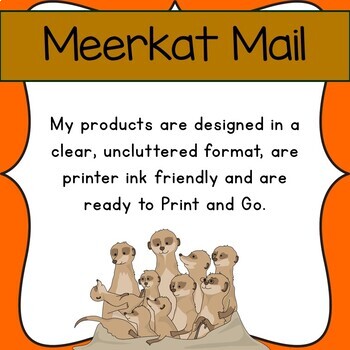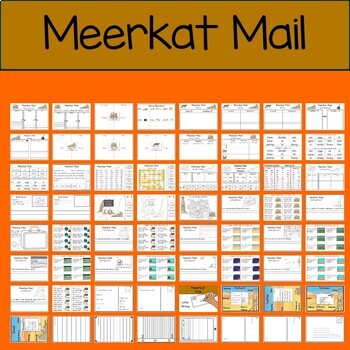Meerkat Mail Book Study- Print & Go Literacy & Letter Writing Activities
- Zip
Description
Meerkat Mail English Language Arts Activities (ELA)
Meerkat Mail Letter Writing Activities
This packet includes ready to go story companion activities for a variety of levels from Pre-K to grade 3 so you can use one wonderful storybook across many classes!
Use this book companion after reading the delightful Meerkat Mail by Emily Gravett. I am not affiliated with the author, and the book is not included. Not only will your students LOVE this interactive picture book, they will also have fun with these follow-up activities targeting literacy and letter writing!
Sunny the meerkat lives with his enormous family in the Kalahari Desert. They are all very close ...so close, in fact, that one day Sunny decides it is just too crowded and packs his bags. He is off to visit his mongoose cousins. But from the watery world of the Marsh Mongoose to the nocturnal lifestyle of the Malagasy Mongoose, Sunny just does not fit in. And who's that shadowy figure who seems to be following him around? There's so much to enjoy, from the newspaper cuttings on the endpapers to the wittily accurate information about each mongoose species Sunny visits on his journey.
My products are designed in a clear, uncluttered format utilizing graphic organizers.
They are simple to read and are printer/ink friendly.
They are ready to print and go.
Fonts included:
- Simple Print Font in US Letter size (US spelling),
- Qld Beginners Font in A4 size (UK spelling)
- NSW Font in A4 size (UK spelling)
- Victorian Font in A4 size (UK spelling)
- UK Sassoon font in A4 size (UK spelling)
These high engagement and differentiated Meerkat Mail activities include:
- A beginning, middle and end retell page.
- Retell page for Sunny's changing emotions.
- Story map for characters, setting, problem and solution.
- Story elements organizer.
- KWL chart (2 options provided- learnt or learned).
- Problem solution organizer (with lines & without).
- Character likes dislikes organizer (with lines & without
- Character traits for Sunny, meerkats and jackals.
- Cut and paste word sort for nouns, verbs and adjectives (with answers).
- Word sort for nouns, verbs and adjectives (with answers).
- Word search with answer key.
- 2 sentence transformations with a differentiated word matching page.
- Cloze page.
- Maze activity for pencil control and or visual discrimination.
- Cut and paste and labelling activity in colour and B/W.
- Book reviews, generic and text specific.
- 10 Writing and or discussion prompts to make connections about the text in 2 formats, a worksheet to write on, or multiple writing prompts on a page to save on photocopying.
Letter Focused activities:
- Anchor charts for letters, envelopes, emails and postcards.
- Postcards from Sunny innovations.
- Blank templates for letters, emails, envelopes and postcards.
Beginning Middle End
Identifying the most important event from the beginning, middle and end of the story help a reader understand how organization, sequence, and plot make a good story. This can then be applied to their own writing. Teaching students to retell occurrences in a story helps them become more accurate in summarizing and monitoring their understanding.
Story elements
A graphic organizer, such as a story map, can help students visually organize a story's elements, increasing their ability to retell, summarize, and comprehend the story.
Sentence transformations
This activity gives students practise with sentence structure (Syntax). Transforming words that are out of order forces students to think about each word in a sentence rather than only memorizing an entire phrase without understanding the importance of structure.
Writing prompts
Making connections is thinking about the text in relation to ourselves, other texts, and the world. Making connections provides the basis for learning, as students connect new information with their own experiences. This develops fluency with their comprehension skills.
KWL charts
This note-taking device guides students through a three-step process to activate background knowledge, develop a purpose for learning, and summarize.
Literal, Inferential, and Evaluative Question Answering
- Literal questions have responses that are directly stated in the text.
- Inferential questions have responses that are indirectly stated, induced, or require other information.
- Evaluative questions require the reader to formulate a response based on their opinion.
These questions will enhance your students reading comprehension and critical thinking skills as they learn to search for clues and symbolism in the stories they read.





